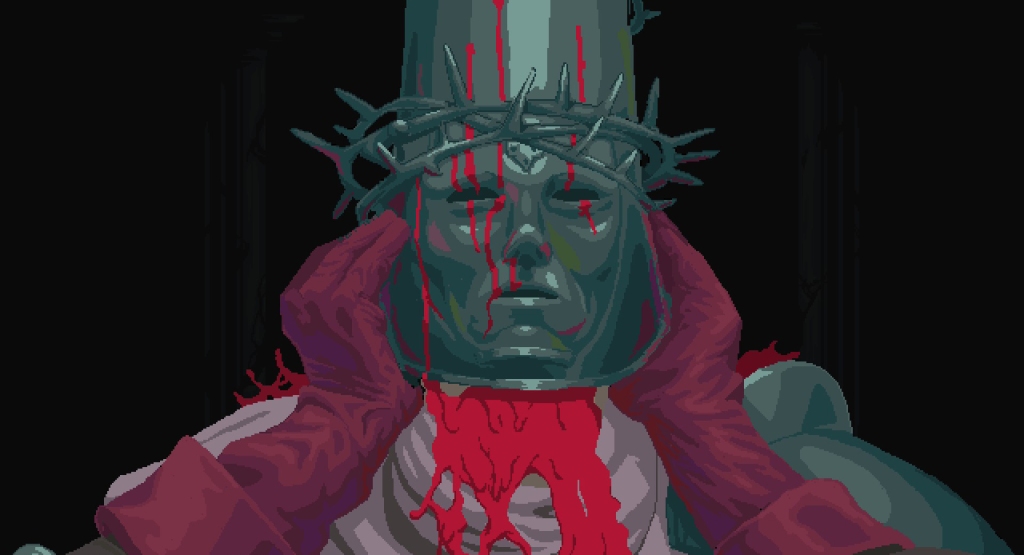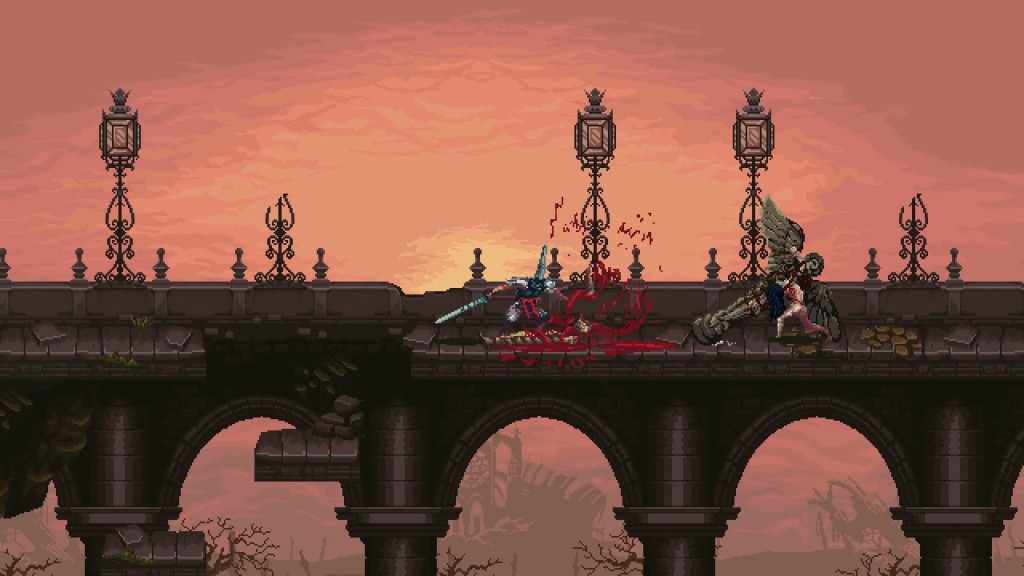Religious imagery is perhaps the most popular theme in any form of media. Despite this, perhaps nothing has a more brutal take on the Christian mythos as Blasphemous. Rooted in Spanish Catholicism, Blasphemous constructs a world that takes the religious cornerstones of guilt and penance to extreme levels. The game is a classic metroidvania, and a well-designed one at that. While Blasphemous does not innovate on the genre, its masterful art, imagery, and atmosphere are plenty to make it stand out in a sea of similar games.

Blasphemous does not hesitate to make its gore apparent to the player. The opening moments of the game have the player awakening on a pile of corpses, all which are doppelgangers that resemble the player. You immediately encounter an unsightly beast; a warden who appears to be searching for survivors of the unseen massacre and slaughtering them. The main character, the Penitent One, slices the warden open to fill his helmet with blood and dons it before continuing on his quest.

After the player’s introduction to the game, you become aware of the parallels between this fictional world and historical events such as the operation of the Spanish Inquisition. The world of Blasphemous is centered on the ideas of guilt and penance. Everybody worships what is known as the Grievous Miracle, a magical force that arbitrarily doles punishments to the world’s inhabitants. People see these punishments as blessings, and happily endure extreme pain as a way to repent for their sins. Self-flagellation, bare-footed pilgrimages, carrying crosses, and whippings are all common forms of mortification of the flesh. Everyone carries the weight of guilt, and consequently seek penance through suffering to receive forgiveness.
The imagery of Blasphemous is particularly striking. Every character is suffering at the hands of the Grievous Miracle, everyone is on some journey to complete their punishment. Everything in the game mirrors the grandiose nature of religious text. The areas are named things like “The Mountains of the Endless Dusk” or “Where Olive Trees Wither”. There are sprawling cathedrals and towering statues that dwarf the Penitent One. The artwork is absolutely stunning. The immaculately designed backgrounds, the gothic architecture, the detailed character models, and the violent animations superbly represent the brutal yet magnificent vision of this religious world.

A key aspect of any metroidvania is the level design and the emphasis on natural exploration. Blasphemous has a fairly unique approach to the design staple of finding new items that unlock new areas of the map. Interestingly, Blasphemous can be completed with only the abilities and items that you begin the game with. All subsequent upgrades are found off the beaten path and are entirely optional. I find this to be remarkable as most games in the genre follow the same formula of beating a boss to acquire an upgrade that lets you progress to the next area. But Blasphemous encourages the player to make discoveries on their own.
I was engrossed in exploring the world of Blasphemous. Part of the reason was because of how the game framed its upgrade system. Many metroidvanias make the mistake of having upgrades be obvious in their functionality. For example, many games include a double-jump that allows the player to reach higher up areas. This is fine, but it takes a little mystery out of exploration and some excitement when you finally do unlock the double-jump. When you see a ledge that’s too high to reach, you know that you will eventually unlock a double-jump. And when you do gain access to that ability you already know where it can be used. But Blasphemous takes a different approach, as most of its upgrades are framed as a tool that the Penitent One uses to change their perception of the world around them.

For example, a blessed cloth allows the player to hear the last thoughts of some of the deceased scattered around the world. These spectral thoughts are often hints to puzzles that the player would have no way of solving otherwise. Another upgrade reveals floating, bloody platforms to the Penitent One. These platforms can be used to reach secret ledges that couldn’t be accessed otherwise. Whenever you do finally obtain one of these exploration upgrades, it immediately makes you wonder what effect it has on the world around you. It makes me want to actually explore, rather than being prompted to by the game. This natural desire to unearth the secrets of the world is a property that is key to any metroidvania, and Blasphemous nails this.
I’d argue that the weakest aspect of Blasphemous is its combat and movement. There’s something about this game that makes its gameplay feel a little off compared to its contemporaries like Hollow Knight and Ori and The Blind Forest. The animations and hitboxes of Blasphemous can feel a little desynced at times. It’s not offensively bad but I definitely felt like it wasn’t as clean or polished as some of the masterful metroidvanias that have been released recently. The combat itself is incredibly simplistic, which can be a great direction if utilized properly. Not every game needs to have crazy combos or require split second reaction time. Blasphemous relies more on learning enemy patterns and reacting to them appropriately.

This approach shines during the numerous boss fights scattered throughout the game. The bosses have a variety of attacks and abilities that will test the player’s ability to learn and read their movements and tells. Unfortunately, the basic enemies in the game are not as entertaining as the bosses. The issue is that the vast majority of enemies only have a single attack, and once you learn how to react to that attack, the encounter becomes trivial. You always know what they are going to do, so you barely need to even pay attention anymore. Moreover, because the combat is so simplistic, you cannot make it more entertaining for yourself by coming up with new combos or trying different techniques.
While Blasphemous does have a progression system that unlocks new attacks, you can rarely string these techniques together in any meaningful way. Most enemies will succumb to a few simple swings of the sword, so you will never get to even try more complex inputs. The lack of build customization is also an issue. Many games with simplistic combat can get away with it by offering the player diversity in how they build their character. Blasphemous does offer three different categories of items to equip, but they do a poor job at truly distinguishing different playstyles.

The first category of items that can be equipped are called prayers. Prayers are essentially magic spells that use a resource called Fervour which is gained by attacking and executing enemies. You can only equip one prayer at a time, and they are fairly weak in general. They cost a hefty amount of Fervour so you cannot cast them often, they rarely do more damage than just slashing at enemies, and they take a long time to cast which leaves the player vulnerable. They are just underwhelming and I often forgot that I had a prayer equipped because their use cases are so few and far between. The only way that I see prayers being valuable is if the player makes a hyper-specialized build using rosary beads.
Rosary beads are items found throughout the world, and a few can be equipped at any time. Individually, most of them are fairly mediocre. A few are exceptionally powerful but they are difficult to uncover. The problem is that the best rosary beads are pretty generalist bonuses. Things like doing more damage and being invincible while healing are too good to pass up. Other rosary beads provide protection against certain elements, but these are only useful against particular bosses. There’s not really a great way to make an interesting build using rosary beads outside of a prayer-focused approach. You could increase prayer damage, decrease prayer cast time, increase maximum Fervour, and increase Fervour generation to give yourself a prayer casting focus rather than a sword slashing one. But I doubt most players will even contemplate going this route considering how weak prayers are in the first place.

The last customizable option is possibly the worst: Mea Culpa hearts. The Mea Culpa is the name of the sword that the Penitent One carries, and you can equip specialized hearts into the sword to give it different effects. The interesting thing is that all bonuses are tied to some drawback. For example, you can do more damage at the cost of taking more damage. The problem is that the drawbacks often outweigh the bonuses. It almost feels like a detriment to equip many of these hearts.
While the lack of build diversity does hurt the game’s combat, it also dissuades the player from spending too much time hunting for secrets. With two fairly unimportant collectibles and three unimpactful build item categories, most things that you uncover in the world of Blasphemous are disappointing. The act of exploration was entertaining, but I can see players getting dissuaded from continuing after the majority of their rewards are useless trinkets and baubles.
As a bit of a side note, I played Blasphemous after the first expansion was released, and before the second expansion was announced. I usually don’t mention this sort of thing, but Blasphemous infamously was janky immediately following its release. It’s a shame that people who bought the game early were burnt by it not being fully-baked, but if that was the case for you than I encourage you to give it another chance with the recent patches.

Overall, Blasphemous is more than just a competent metroidvania. It has an identity of its own, with strong theming and powerful imagery. The sheer brutality of its art and world alone is enough to make it an experience worth your time. Its unique take on how exploration is framed makes Blasphemous a worthwhile metroidvania among its peers. Even thought combat was overly simplistic and repetitive, the rest of the game made up for that. It is for these reasons that I give Blasphemous an 8/10. In a genre brimming with similar games, the style and atmosphere of Blasphemous set it apart.



